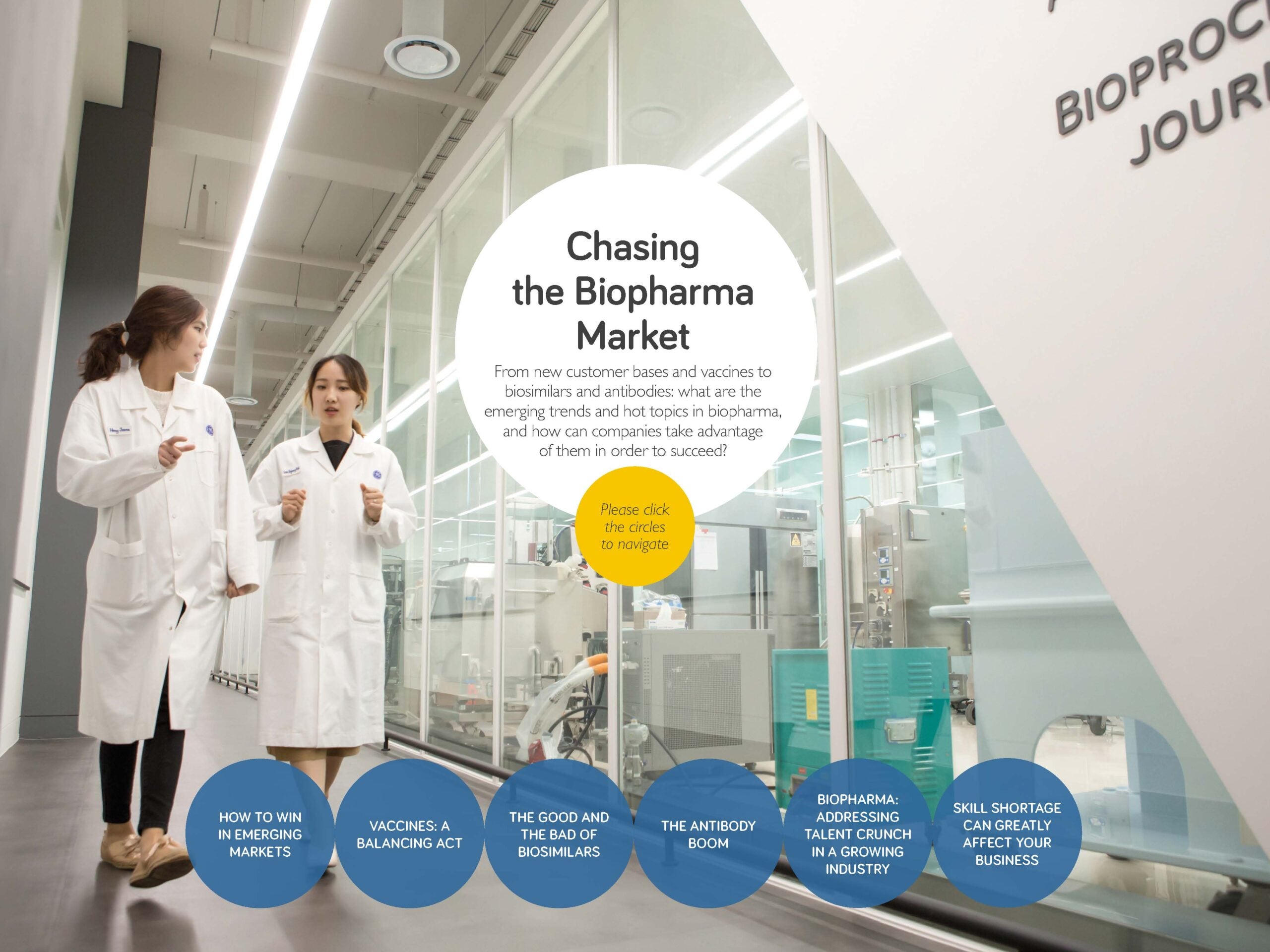
The ballroom concept was originally defined in the International Society of Pharmaceutical Engineers (ISPE) Baseline Guide: Volume 6 – Biopharmaceutical Manufacturing Facilities (2013) as “A large manufacturing area that has no fixed equipment and minimal segregation due to the use of functionally closed systems.”
This concept includes placing the bioprocess equipment on wheels, rather than in permanently fixed positions. Advances in single-use systems and bioprocess automation have facilitated the practicality of closing systems, but the gating factor for industry acceptance was the Pharmaceutical Inspection Co-operation Scheme (PIC/S) determination that clean-room requirements for bioprocessing can be relaxed— or even eliminated—if your process is closed. This signal of acceptance paved the way for industry adoption, which in turn has created new opportunities for risk reduction, cost savings, and facility flexibility.
Early adopters of the ballroom approach have received a lot of attention. Now their ballroom facilities have been inspected and licensed, they have added credibility to the operational feasibility and regulatory acceptance of open architecture suites. But this was often perceived as an approach best suited to large, established biomanufacturers. Questions remained around the practicality around its acceptance in a CDMO facility.
Modified ballroom, dance floor
As originally conceived, the ballroom concept would provide flexibility to deploy equipment to meet the needs of a specific process, scale-up or scale-out by simply wheeling in and connecting additional operations units, or running multiple processes in one space.
Another view of flexibility was quickly revealed in relation to facility design; the ballroom doesn’t have to be a single, large space. It can be distributed over adjacent smaller spaces, connected with through-the-wall connections to maintain process closure. This modified ballroom application, which has come to be known by some as the “dance floor” concept, enables application of the ballroom concept in existing facilities with minimal modification.
Fujifilm Diosynth Biotechnologies had considered a green-field implementation for a new CDMO expansion, but ultimately decided to convert an existing, unused, facility into a modified ballroom design, utilizing single-use equipment. The facility, originally planned as a traditional stainless-steel manufacturing site, was already divided into rooms. Rather than reconfigure the space, it made minor changes and through-the-wall connections to implement a modified ballroom in the existing space.
While most of the manufacturing area does not follow cleanroom requirements, Fujifilm Diosynth decided to implement clean-room standards in the final, post-nanofiltration space. Product at this point is most concentrated, therefore most precious, as it is not remediable should it be contaminated. With the dancefloor implementation, Fujifilm Diosynth could create a clean room in this single area, while avoiding the infrastructure and ongoing costs needed to create a clean-room environment for the entire process. This safeguard also instilled confidence for both the Fujifilm Diosynth staff and their multiple CMO clients.
Maximize flexibility while driving risk out of the system
Fujifilm Diosynth adapted an existing facility, leveraging a ballroom concept to maximize space utilization while minimizing the capital expenditure and the ongoing expenses associated with creating and maintaining a clean-room environment for the entire bioprocess. As a CDMO, it also gained a new level of flexibility to address client needs. But how would clients respond?
The response has been positive, with valuable—and unexpected—lessons learned. Thomas Page, of Fujifilm Diosynth, says “Customers like the robustness of the approach, which goes beyond quality to decrease business and schedule risk. Deploying a closed system in a facility with high level of controls will give a high level of quality, and therefore supports the ability to deliver on time and the ballroom approach provides enhanced risk-control.”
Page believes that closed systems will become an expectation from regulatory agencies. Cytiva’s Parrish Galliher anticipates that bioprocess manufacturers will adopt a similar modified ballroom model, where the seed train and post-filtration operations are in clean rooms, while the upstream, downstream and filtration operations are in a shared space. This environment would have minimal environmental controls but strong closed-system security.
Practical considerations for implementing the ballroom approach
The closed-system dancefloor approach enables biomanufacturers to take full advantage of the flexibility offered by single-use systems by simplifying the logistics, eliminating the need for gowning and the complexity of bringing single-use equipment into a clean-room environment. Parallel process trains can be set up for a single product, or for multiple products, with physical separation of closed systems in a shared space. Robust centralized automation provides the controls needed to manage each process, with segregated products and materials.
After implementing the ballroom and dance floor approach at multiple locations, Galliher has practical advice for biomanufacturers considering this approach.
“Meet with regional regulators early on, still in the design phase. Flag any potential regulatory issues to avoid surprises late in the process. An engineering firm that understands ballroom bioprocessing can help avoid the over-engineering trap and help you realize the full savings of implementing a ballroom for bioprocessing. Success is in the details of the connections, the assemblies and the standards you adhere to. The major unit operations don’t really change.”
And finally, “Connectors, connectors, connectors. When planning a closed bioprocess facility, pay close attention to how your equipment will be connected and how your connections will be validated.”
Galliher sees a growing role for the ballroom concept and its key enabler, single-use technology. “Although single-use technology is well-established, and has made its way into commercial licensed facilities, there is more innovation in this field that will further enhance its versatility into new markets and technologies.”
The next step: Standardized connectors
If there is one consistent pain point among biomanufacturers implementing closed bioprocesses, it is the lack of standards in connectors. At every equipment change-over, the process equipment must be connected. While the methods of making sterile connections are reliable and well-known, the lack of standards for connector sizes, materials and construction often requires ordering custom connectors, with the associated costs and complexity. Bioprocessors’ needs will be better met when equipment manufacturers can agree on standards for sterile connectors. Standardized connectors will also lessen the validation burden.
Galliher envisions expanding and strengthening system closures. Single-use systems that are currently not closed, such as cell harvest depth filters and UF/DF membrane cassette systems, will be replaced with closed processing systems or systems validated to be “functionally closed” after assembly and in-situ sanitization. Ultimately, techniques and methods will be developed to dismantle the single-use production line after use in a closed fashion, avoiding contamination of the open ballroom facility. This will result in a production line that is closed not only during bioprocessing, but also during change-over and disposal, improving environmental, health and safety standards.
Will the ballroom take over the bioprocess world?
There is no denying the appeal of the ballroom approach in emerging markets. The facility infrastructure, both in initial investment and the ongoing operating expenses, are considerably lower than a traditional clean-room facility. The facility will require a smaller footprint, less engineering, lower construction costs, and less time to completion.
The environmental impact is also much lower when clean-room standards are limited to the seed train and post-filtration operations. And while it may sound trivial, eliminating the need for gowning results in lower labour costs and greater efficiency. These advantages will tip the balance towards ballroom or dance floor implementations in emerging markets. The Amgen facility in Singapore has already danced into the ballroom spotlight.
The ballroom concept is also particularly suitable for applications that require multiple or rapid change-overs, and therapies with small scale production. With a growing focus on precision healthcare, production environments will need to transition into a more flexible environment.
While there is still a place for large clean-room facilities with stainless-steel bioprocessing for block-buster drugs, manufacturers looking to expand capacity or bring a new biopharmaceutical to market are already looking hard and with interest at the ballroom concept. As the existing stainless- steel bioprocess facilities come to end-of-life, we’ll likely see more biomanufacturers dancing their way into the ballroom.
For more articles from Cytiva click HERE



